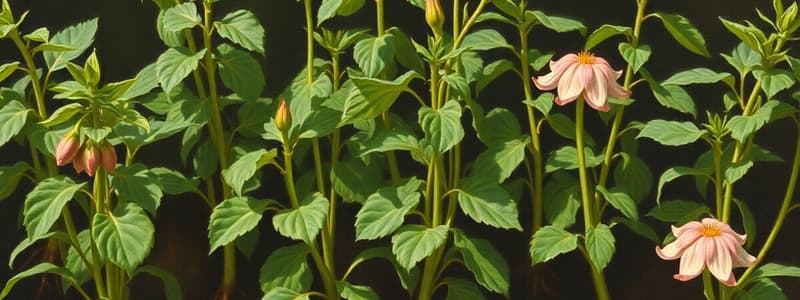Podcast
Questions and Answers
Which structure is not involved in vegetative propagation through stems?
Which structure is not involved in vegetative propagation through stems?
- Leaves (correct)
- Tubers
- Rhizomes
- Corms
What is a key difference between corms and bulbs?
What is a key difference between corms and bulbs?
- Corms do not have non-functional leaves. (correct)
- Corms store more starch than bulbs.
- Bulbs lack the ability to produce new plants.
- Bulbs have fleshy leaves while corms do not.
Which plant structure develops from the nodes of stolons?
Which plant structure develops from the nodes of stolons?
- Cormels
- Tubers
- Rhizomes
- Plantlets (correct)
Which of the following statements about tubers is incorrect?
Which of the following statements about tubers is incorrect?
What type of stem do ferns utilize for vegetative propagation?
What type of stem do ferns utilize for vegetative propagation?
What is the primary function of bulbs in the context of plant propagation?
What is the primary function of bulbs in the context of plant propagation?
Which statement about cormels is accurate?
Which statement about cormels is accurate?
Which of the following best describes stolons?
Which of the following best describes stolons?
Flashcards
Stolon
Stolon
A horizontal stem that grows above ground, producing leaves and roots at nodes, which develop into plantlets. These plantlets form new plants when placed in soil.
Rhizome
Rhizome
A horizontal underground stem that can produce shoots and roots, developing into new plants provided suitable conditions exist.
Bulb
Bulb
A specialized underground bud with fleshy leaves, serving as food storage for future developing plants. Bulbs divide naturally, forming new plants.
Corm
Corm
Signup and view all the flashcards
Tuber
Tuber
Signup and view all the flashcards
Vegetative Propagation through Stems
Vegetative Propagation through Stems
Signup and view all the flashcards
Node
Node
Signup and view all the flashcards
Axillary Buds
Axillary Buds
Signup and view all the flashcards




